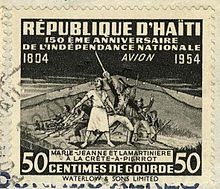Marie-Jeanne Lamartiniére

Marie-Jeanne Lamartinière (fl. 1802), known in history only as Marie-Jeanne,[1] was a Haitian soldier, woman of color, and reportedly a "dazzling beauty."[2] She served in the Haitian army during the Haitian Revolution, which was a successful anti-slavery and anti-colonial insurrection by self-liberated slaves against French colonial rule. It took place 1791-1804.
Haitian Revolution Service[]
Marie-Jeanne served at the Battle of Crête-à-Pierrot (4 March to 24 March 1802) with her husband Louis Daure Lamartinière.[3][4][circular reference] She fought in a male uniform standing along the fort's ramparts bearing both a rifle and a sword.[5] She made a great impression with her fearlessness and courage, and was said to use the long rifle to snipe on the wounded French soldiers below with "a skill all the men applauded."[3] It is said to have boosted the morale of her colleagues with her bravery.[2]
When not fighting, Marie-Jeanne nursed her injured comrades. When describing her allocation of her scarce water supply to parched and dying troops, Bell[3] states,
"Marie-Jeanne gave water with a silver serving spoon that hung from her sash on a fine chain. From the gourd she carried as she filled the spoon just short of the brim and slipped between the jaws of [the patient]." ... [A doctor noticed] "the short knife which rode in her sash between the spoon chain and her sword. Two days before she'd slit the throat of a man so maddened by thirst he'd tried to snatch the water gourd from her — done it as neatly as any peasant woman letting blood from a hog or snapping the head off a chicken. It had been a mercy killing, for the others of the garrison would surly have torn the offender limb from limb."
Later life[]
Her husband Louis Daure Lamartinière was killed in battle in 1802.
Her life after the independence is unknown. An old story says that she, for a time, was involved in a relationship with emperor Jean-Jacques Dessalines, who admired her courage, and that she later married the officer Jean-Louis Larose.[1] This is unconfirmed but comes from a contemporary source, related by one of the other soldiers at Crête-à-Pierrot, and is considered trustworthy.
Similar Soldiers of Note[]
Most women participating as soldiers during the revolution remain anonymous, and only a few, of which Marie-Jeanne is one, have been known in history. Other contemporary examples of women in the Haitian army were Victoria Montou and Sanité Belair.
References[]
- ^ Jump up to: a b "Marie-Jeanne Lamartinière", Wikipédia (in French), 2017-10-29, retrieved 2019-04-17
- ^ Jump up to: a b Madiou, Thomas (1803). Histoire d'Haïti: 1799-1803 (in French). Editions H. Deschamps.
- ^ Jump up to: a b c Bell, Madison Smartt (2007-12-18). The Stone that the Builder Refused: A Novel of Haiti. Knopf Doubleday Publishing Group. ISBN 9780307427977.
- ^ "Louis Daure Lamartinière". Wikipédia (in French). Retrieved 2019-04-17.
- ^ "Femmes d'Haiti : Marie-Jeanne". www.haiticulture.ch. Archived from the original on 2012-04-23. Retrieved 2019-04-17.
- Haitian independence activists
- Women in 19th-century warfare
- Women of the Haitian Revolution
- Women in war in the Caribbean